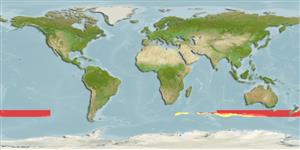Klassifizierung / Names
Namen | Synonyme | Catalog of Fishes(Gattung, Arten) | ITIS | CoL | WoRMS | Cloffa
Elasmobranchii (Haie und Rochen) (sharks and rays) >
Squaliformes (Sleeper and dogfish sharks) >
Somniosidae (Sleeper sharks)
Etymology: Scymnodalatias: scymno-, referring to previous placement in Scymnodon; dalatias, referring to lack of dorsal spines like most sharks in the family Dalatiidae (sometimes included within Somniosidae). (See ETYFish); albicauda: albus (L.), white; cauda (L.), tail, referring to white markings on caudal fin. (See ETYFish).
Environment: milieu / climate zone / depth range / distribution range
Ökologie
seewasser bathypelagisch; ozeanodrom (Ref. 51243); tiefenbereich 150 - 510 m (Ref. 6871). Deep-water; 42°S - 50°S
Eastern Indian Ocean: southern Australia. Southwest Pacific: New Zealand.
Size / Gewicht / Alter
Maturity: Lm ? range ? - ? cm
Max length : 111 cm TL Männchen/unbestimmt; (Ref. 26346)
Kurzbeschreibung
Morphologie | Morphometrie
Rückenflossenstacheln (insgesamt): 0. Grey and white, mottled with large brown or black spots; tail mostly white with black tips (Ref. 26346). Dorsal fins small, pectoral fins angular, and an asymmetric caudal fin with a dark-tipped upper lobe (Ref. 6871).
Oceanic (Ref. 6871). A rare species known only from a few specimens taken by tuna longliners and trawlers (Ref. 6871). Ovoviviparous (Ref. 205), with at least 59 young in a litter (Ref. 26346).
Life cycle and mating behavior
Geschlechtsreife | Fortpflanzung | Ablaichen | Eier | Fecundity | Larven
Probably ovoviviparous (Ref. 6871), with at least 59 young (Ref. 26346). Distinct pairing with embrace (Ref. 205).
Last, P.R. and J.D. Stevens, 1994. Sharks and rays of Australia. CSIRO, Australia. 513 p. (Ref. 6871)
IUCN Rote Liste Status (Ref. 130435)
Bedrohung für Menschen
Harmless
Nutzung durch Menschen
Mehr Information
Alter/GrößeWachstumLänge-GewichtLänge-LängeLängenhäufigkeitenMorphometrieMorphologieLarvenLarven Pop.Dyn.RekrutierungDichteBRUVS
ReferenzenAquakulturAquakultur ProfilZuchtlinienGenetikElectrophoresesVererbbarkeitKrankheitenVerarbeitungNutrientsMass conversion
PartnerBilderStamps, Coins Misc.LauteCiguateraGeschwindigkeitSchwimmstilKiemenoberflächeOtolithsGehirngrößeSehfähigkeit
Tools
Zusatzinformationen
Download XML
Internet Quellen
Estimates based on models
Preferred temperature (Ref.
123201): 7.2 - 11.8, mean 9.2 °C (based on 20 cells).
Phylogenetic diversity index (Ref.
82804): PD
50 = 0.5625 [Uniqueness, from 0.5 = low to 2.0 = high].
Bayesian length-weight: a=0.00389 (0.00168 - 0.00901), b=3.13 (2.94 - 3.32), in cm total length, based on LWR estimates for this (Sub)family-body shape (Ref.
93245).
Trophic level (Ref.
69278): 4.1 ±0.5 se; based on size and trophs of closest relatives
Widerstandsfähigkeit (Ref.
120179): niedrig, Verdopplung der Population dauert 4,5 - 14 Jahre. (Fec=59).
Fishing Vulnerability (Ref.
59153): High to very high vulnerability (67 of 100).
